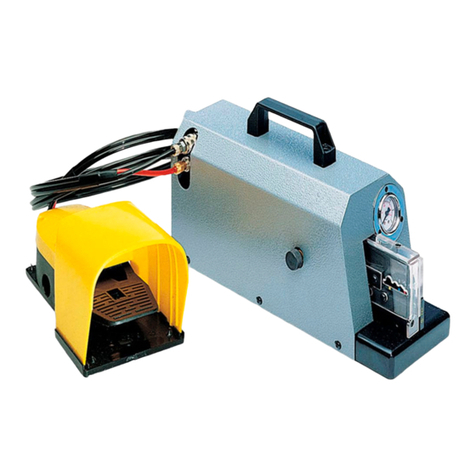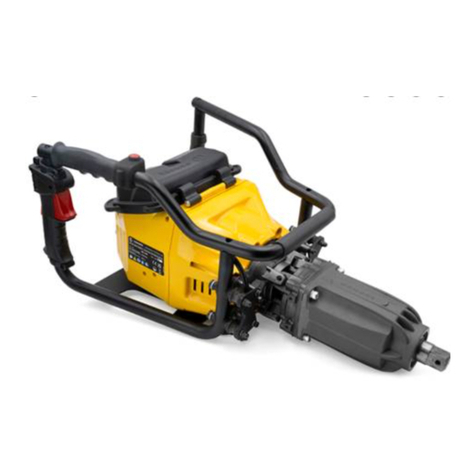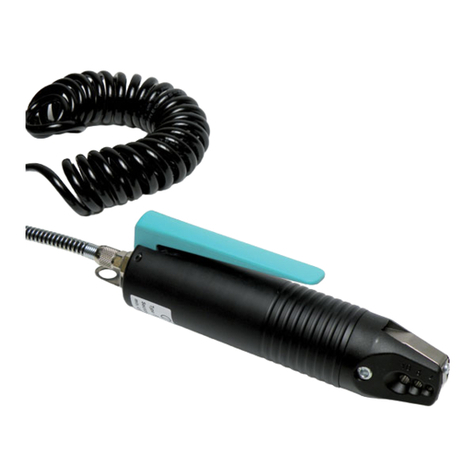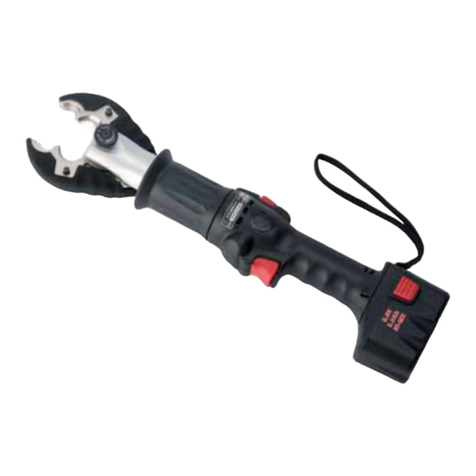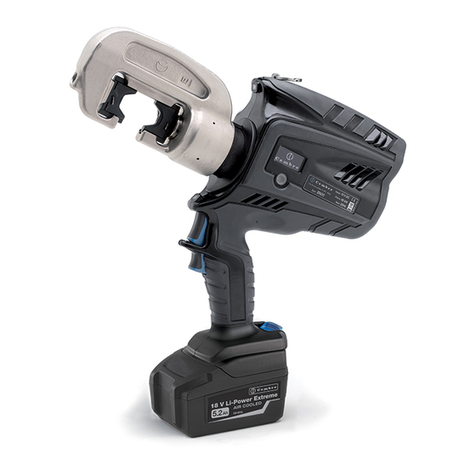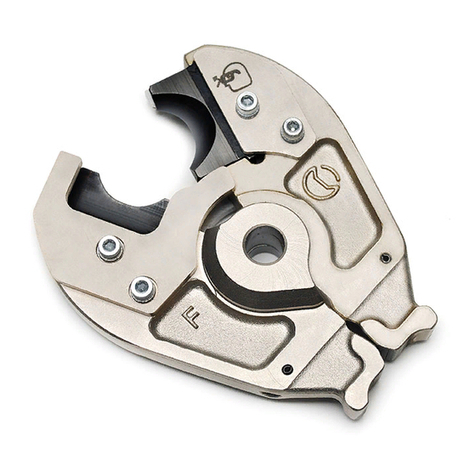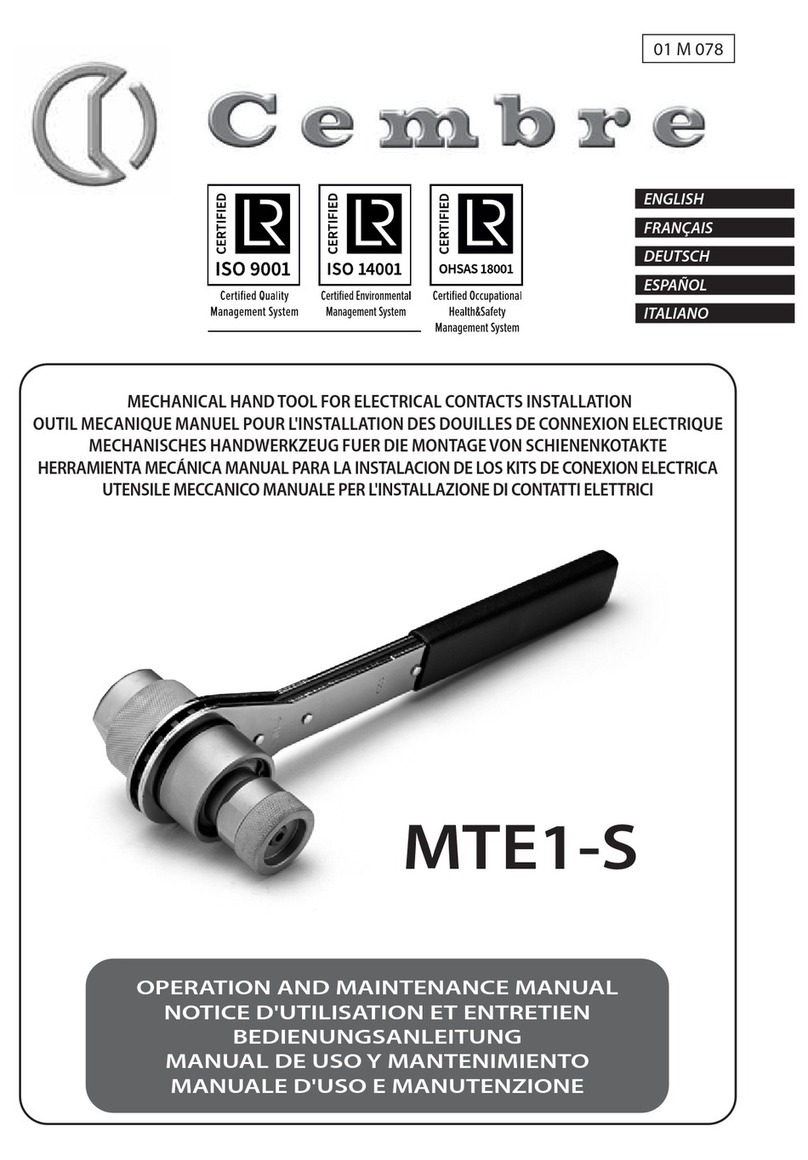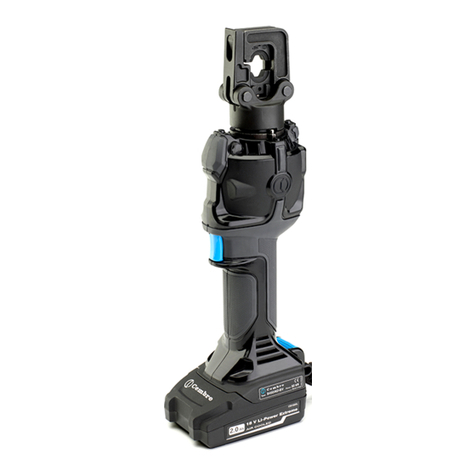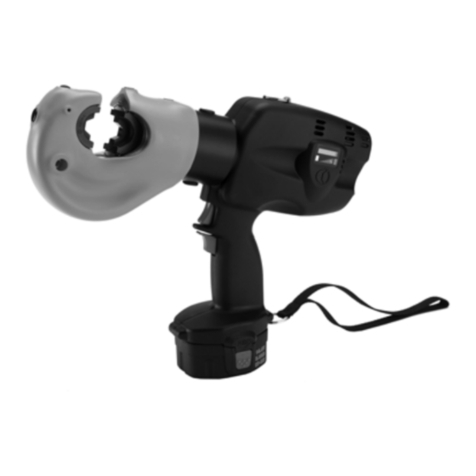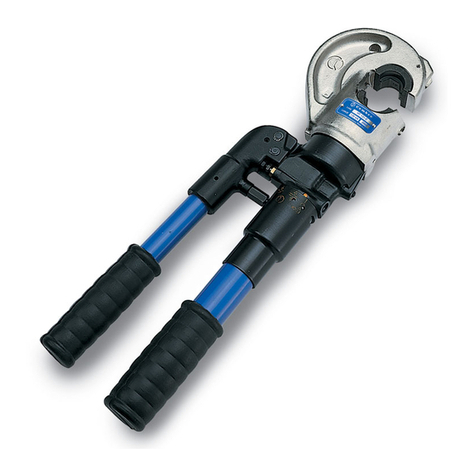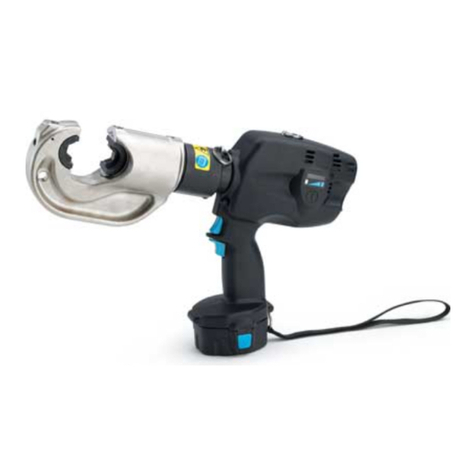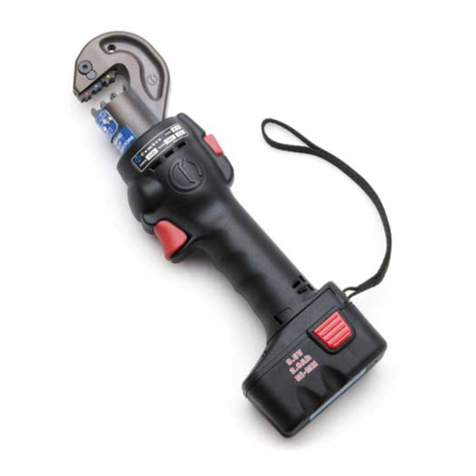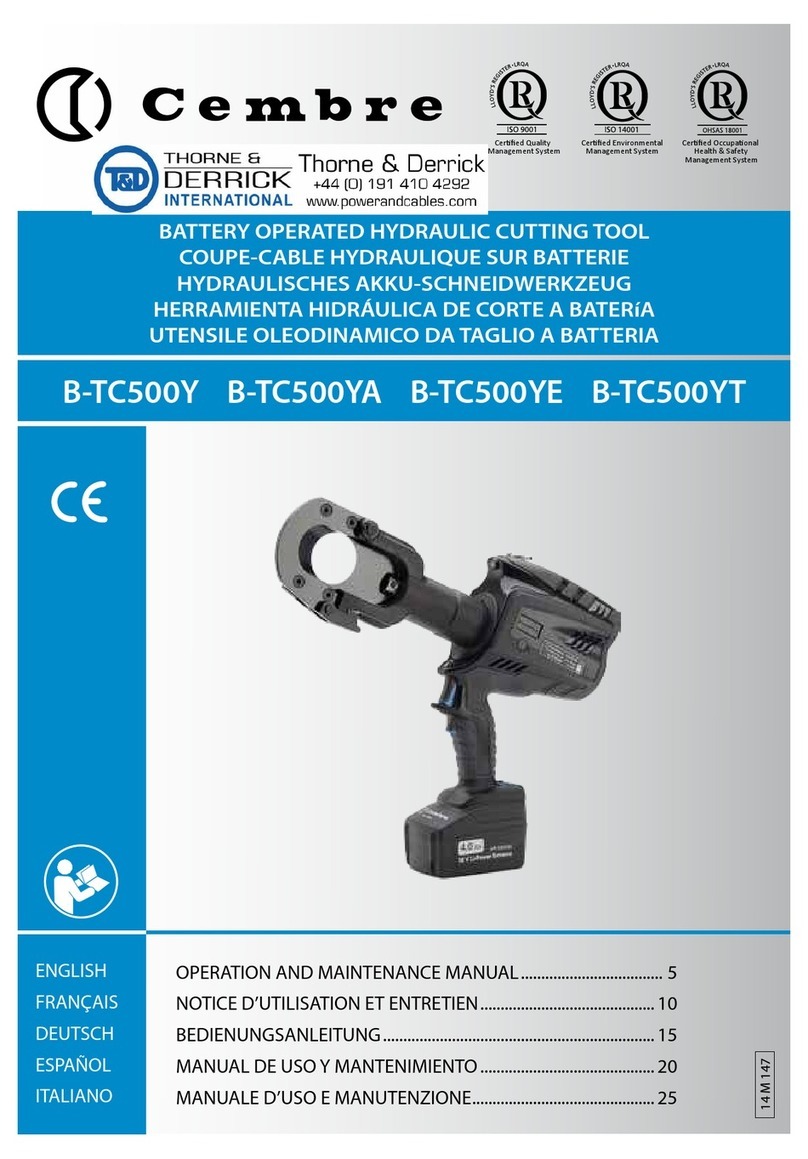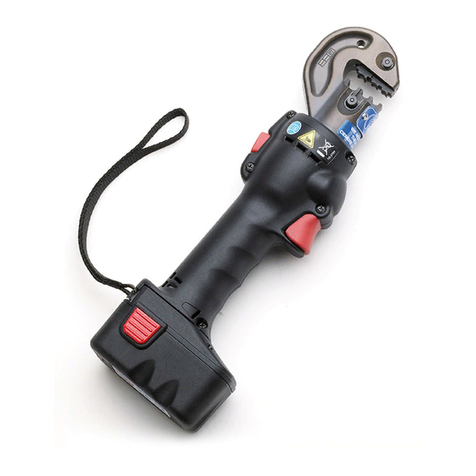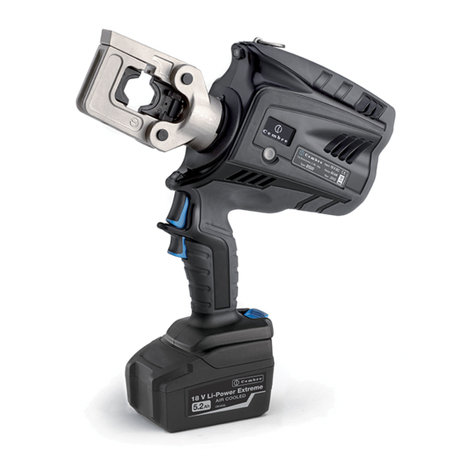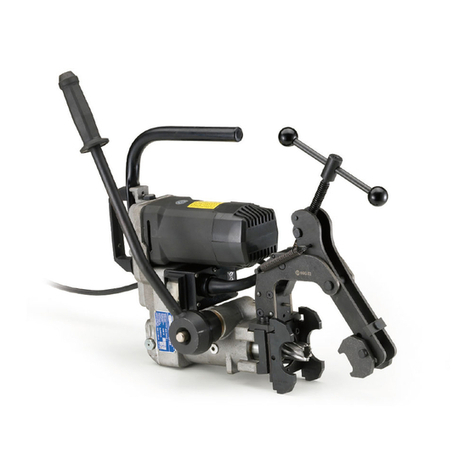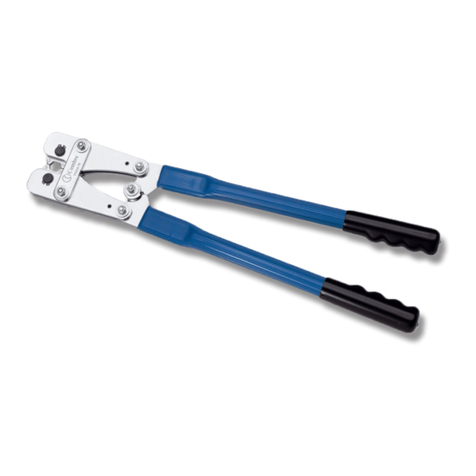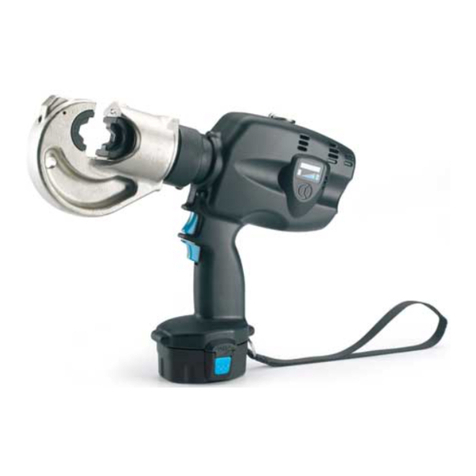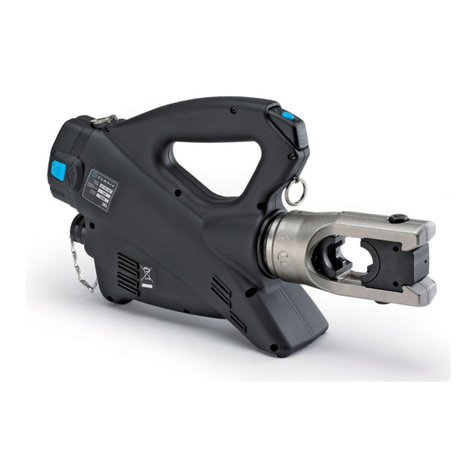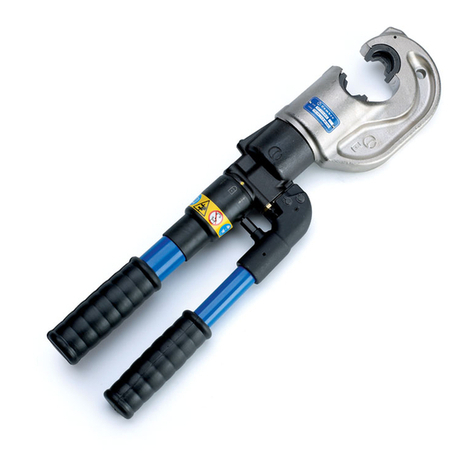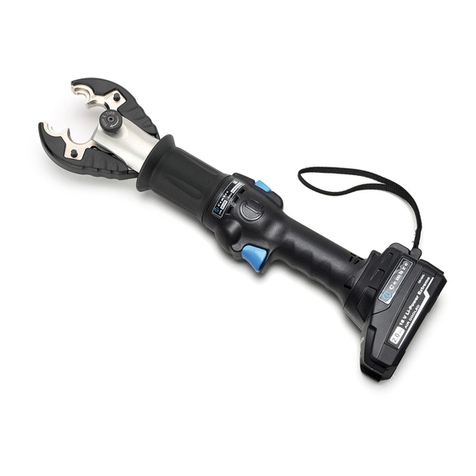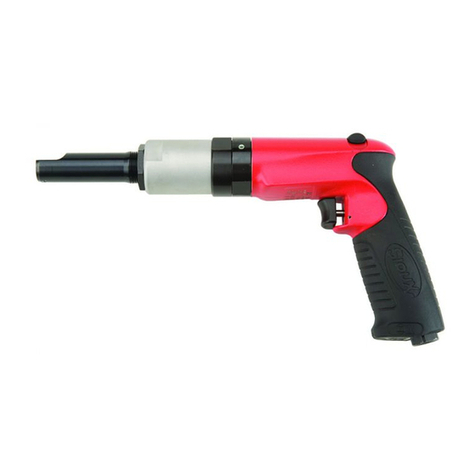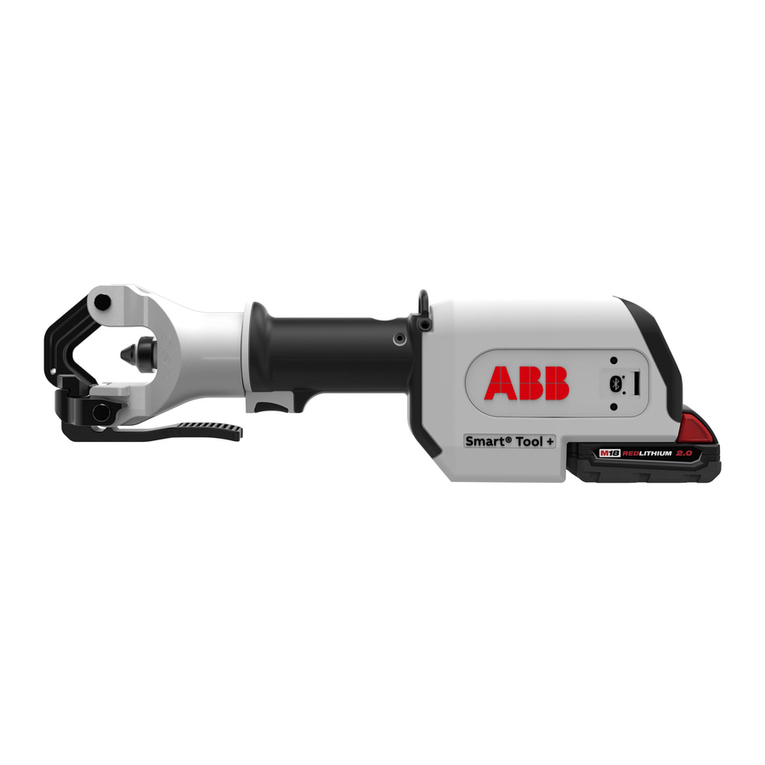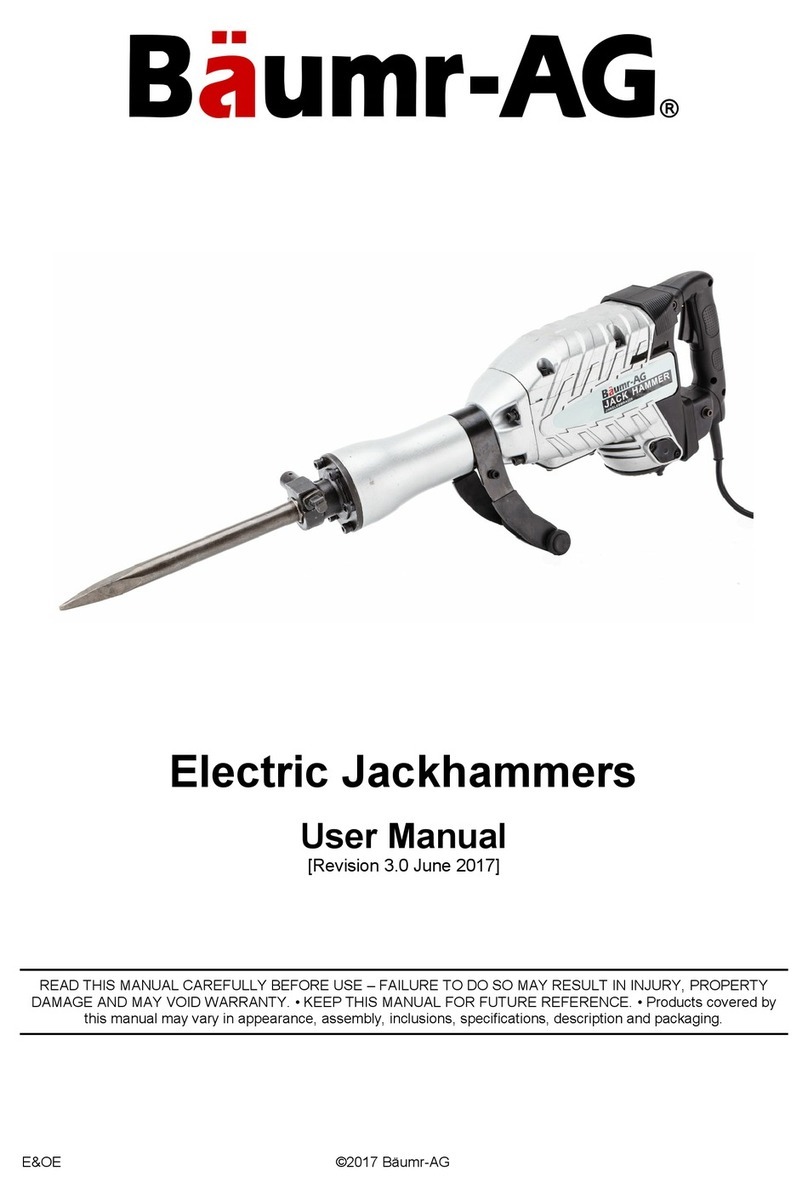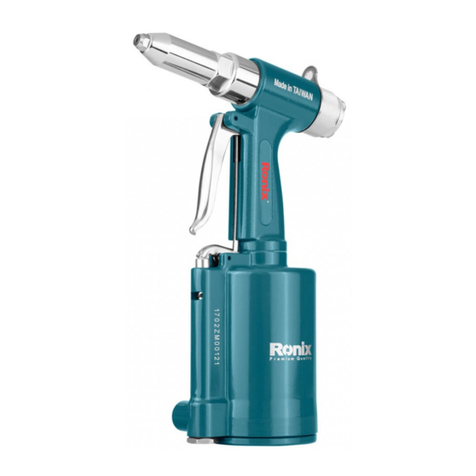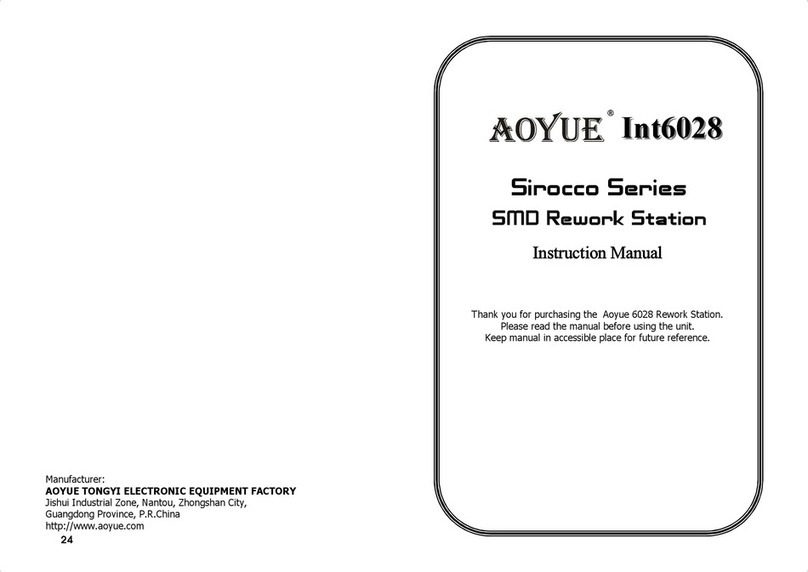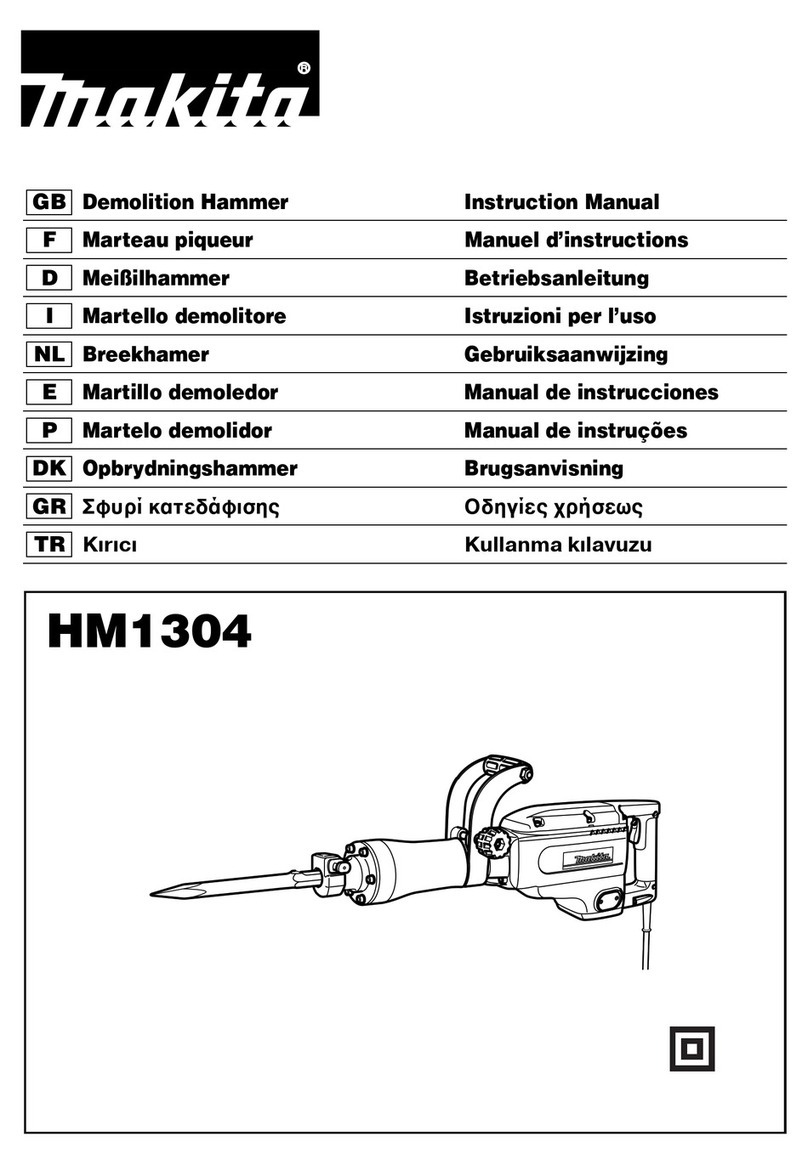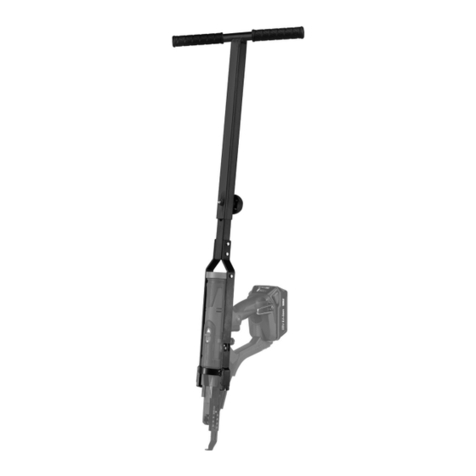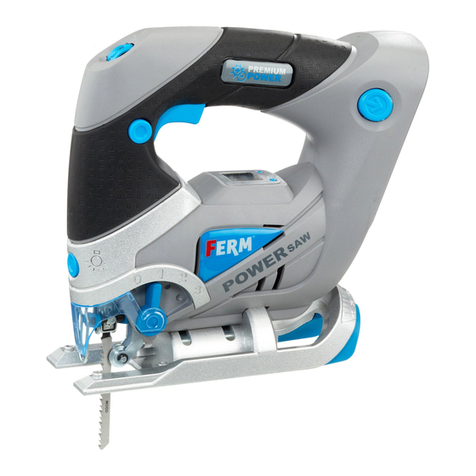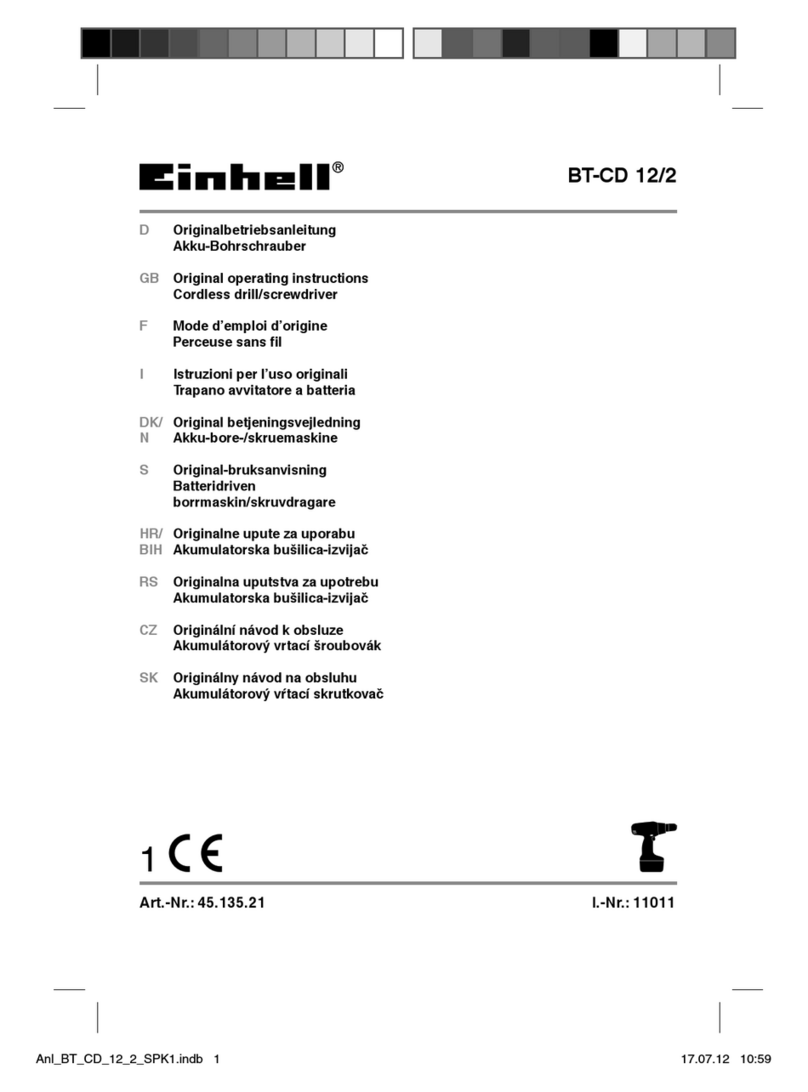
ENGLISH
THE TOOL IS UNSUITABLE FOR CONTINUOUS USE AND SHOULD BE ALLOWED TO
COOLDOWNFOLLOWING UNINTERRUPTED,SUCCESSIVE CRIMPING OPERATIONS;FOR
INSTANCE,HAVING EXHAUSTED AFULLY CHARGED BATTERY IN ONE SESSION,DELAY
BATTERY REPLACEMENT FOR AFEW MINUTES.
O
BSERVE RECOMMENDED REST PERIODS ALSO WHEN USING AN EXTERNAL POWER
SUPPLY.
PROTECT THE TOOL FROM RAIN AND MOISTURE. WATER WILL DAMAGE THE TOOL
AND BATTERY. ELECTRO-HYDRAULIC TOOLS SHOULD NOT BE OPERATED IN POU-
RING RAIN OR UNDER WATER.
3.1) Using the battery charger
– Carefully follow the instructions in the battery charger manual.
3.2) General information on how to use batteries
In order to use the batteries correctly, please follow these rules:
– Use the battery until the automatic residual energy display still has 1-2 LEDs showing:
thismeansthebatteryisalmostcompletelydischarged and no loss in thelifeofthebattery
has been caused.
– Beparticularlycarefulwhencharginganewbattery the first2-3times in order to be certain
of maximising the available energy level.
– Allow the battery to cool down to ambient temperature prior to recharging.
– Rest the battery charger for at least 15 minutes between charges.
4. MAINTENANCE
The tool is robust, completely sealed and requires very little daily maintenance.
Compliance with the following points should help to maintain the optimum performance
of the tool:
4.1) Thorough cleaning
– Dust, sand and dirt are a danger for any hydraulic device.
Every day, after use, the tool must be wiped with a
clean cloth taking care to remove any residue,
especially close to pivots and moveable parts.
4.2) Storage (Ref. to Fig. 3)
– When not in use, the tool should be stored and
transported in the plastic case, to prevent damage.
The case is suitable for storing the tool and the
accessories.
Plastic case: VAL P9, size 543x412x130 mm
(21.4x16.2x5.1 inches), weighs 2,2 kg (4.8 lbs.).
29 6
&RGH1
1FRGH
$UW1U
1FyGL
R
1FRGLF
'(6&5,37,21'(6,*1$7,21%(6&+5(,%81*
'(6&5,3&,21'(6&5,=,21(
635,1*5(66257)('(508(//(02//$
+65$03,6721+9%8&+6(3,6721$93,6721($/7$9(/2&,7$
3803,1*5$03,6721'(3203$*(3803.2/%(13,6721%20%(23,6721(
3203$17(
5(6(592,55(6(592,5g/7$1.'(326,726(5%$72,2
63$&(5(175(72,6(=:,6&+(167h&.',67$1&,$'25',67$1=,$/(
%$&.835,1*$11($87()/67h7=5,1*$1,//23/$67,&2$1(//2%. .
25,1*-2,17725,48(25,1*-817$'(*20$*8$51,=,21(25 .
25,1*-2,17725,48(25,1*-817$'(*20$*8$51,=,21(25 .
&$3:,7+0$*1(7%28&+21$9(&$,0$179(56&+/8660,70$*1(77$321&21
,0$17$3326(5%$72,2&210$*1(7(
6($/-2,17',&+781*-817$*8$51,=,21(,1&$57$.
635,1*5(66257)('(508(//(02//$ .
3,1*283,//(67,)73$6$'2563,1$&,/,1'5,&$';
635,1*5(66257)('(508(//(02//$
5$0*8,'(5,1*$11($8'(*8,'$*(3,6721.2/%(1)
+581*65,1*$1,//2
*8,$3,6721$1(//2*8,'$3,6721(
25,1*-2,17725,48(25,1*-817$'(*20$*8$51,=,21(25
+($'7(7(.23)&$%(=$7(67$
*58%6&5(:9,66$167(7(,0%866&+5$8%(7251,//2*5$12
635,1*5(66257)('(508(//(02//$ .
%$//%,//(.8*(/%2/$6)(5$ .
5$03,6721.2/%(13,67213,6721(
25,1*-2,17725,48(25,1*-817$'(*20$*8$51,=,21(25 .
6&5(:9,66&+5$8%(7251,//29,7(0;
25,1*-2,17725,48(25,1*-817$'(*20$*8$51,=,21(25 .
'2:(//&/,48(7.8*(/+$/7(5623257(%2/$12772/,12
635,1*5(66257)('(508(//(02//$ .
635,1*5(66257)('(508(//(02//$$63,5$=,21( .
%$//%,//(.8*(/%2/$6)(5$ .
:$6+(5521'(//(6&+(,%($5$1'(/$526(77$0&8.
68&76&5(:9,6$63,5$16$8*6&+5$8%(7251,//268&9,7($63,5$=,21(
6($/-2,17',&+781*-817$'(*20$*8$51,=,21(
&203/9$/9(9$/9(&203/.203/9(17,/9$/9&203/9$/92/$&203/
35(665(/($6(6&5(:9,6'('(&2035'58&.$%/$666&+5$8%(7251,//2
'(6&$5*$35(6,219,7(6&$5,&235(66,21(
6&5(:9,66&+5$8%(7251,//29,7(0[
3,1(0%28767,)7&217(5$3817$/(6&$5,&235(66,21(
635,1*5(66257)('(508(//(02//$ .
:$6+(5521'(//(6&+(,%($5$1'(/$526(77$'(17$7$0 .
7,(&2//,(5%,1'(5$%5$=$'(5$)$6&(77$
6($/-2,17',&+781*-817$'(*20$*8$51,=,21( .
4W
4Wq
0HQJH
&GDG
4Wj
,WHP
3LqFH
7HLO
(OHPHQWR
&RPSRQHQWH
TABLE 2 - TABLEAU 2 - TABELLE 2 - TABLA 2 - TAVOLA 2 (ITEM 07)
FIG. 5 Canvas bag "013" for
storing the set of dies
